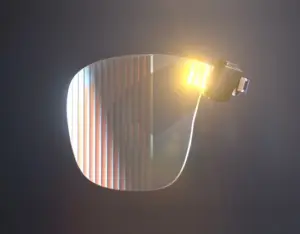Lumus (Ness Ziona, Israel) has developed a second generation Z-Lens product. The new Z-Lens is reported as retaining all of the performance advantages provided by the “two dimension architecture” found in the original, so-called Maximus version of this product. One improvement specifically mentioned is that the new Z-Lens product has an optical engine that is 50%smaller than that of the Maximus.
Z-Lens: Configuration and Features
The image is created by a microprojector module that is hidden in the temple of the eyeglass frame – typically integrated into the top perimeter corner of each lens cutout. The module consists of two components. The first is a microprojector which generates and projects the image. The microprojector itself is comprised of a microdisplay that generates the virtual image. The microdisplay can be any one of a variety of types including microLED, LCoS or laser based. The projector also includes an optics module that collimates the image and directs the light toward the entrance aperture of the second component, a reflective waveguide. The waveguide is the “screen” onto which image is displayed. The waveguide consists of a series of cascading, partially reflective mirrors etched into a coating that sits on a glass lens. The first array of transflective mirrors expands the image in one dimension (vertically) and also diverts light towards the second array. The second array expands the image in a second dimension (horizontally). The two dimensionally expanded image now leaves the waveguide and is reflected straight into the user’s eye. The virtual image seems to hover right in front of the wearer.
A video appended to the end of this article discusses the Z-Lens. The figure below illustrates the configuration of the Z-Lens and its’ integration into the frame of a pair of glasses.

Z-Lens’ new optical engine features 2K x 2K image resolution. With a brightness of 3,000 nits/Watt, it is expected that wearers will be able to view quality augmented reality imagery even in daylight. In addition, having such a bright image can enable a much lower power solution.
The first prototypes of Lumus Z-Lens will feature a 50 degree field of view. The company has, however, a product roadmap for achieving a greater than 80 degree field of view.
Other qualities of Z-Lens based AR glasses may include the following:
- The size and structure of the new Z-Lens is claimed to give manufacturers more options regarding where to position the light aperture. Such flexibility should enable the creation of less bulky and more “natural looking” AR eyewear.
- The elimination of ambient light artifacts or small light glares on the optical display that typically occur in AR eyewear when the display is off. More than that, AR glasses incorporating a Z-Lens do not draw attention to the fact that the wearer is wearing AR glasses because the Z-Lens does not produce any “eye glow.”
- Z-Lens architecture allows for direct bonding of optical elements for Rx prescription glasses. This feature allows consumers to customize their AR eyeglasses to their vision without bulky, heavy inserts, enabling them to be utilized as normal eyewear.
- Provides more privacy through light leakage control. Third parties are not able to see what the AR wearer is viewing.
- A new bonding feature within the Z-Lens allows for dynamic focal lens integration that helps mitigate the vergence – accommodation conflict.
It might be mentioned that there are many reviews of the new Lumus Z-Lens posted on-line. Almost without exception, the reviews are excellent.
Lumus holds more than 430 patents, with more than 540 additional patents pending. Lumus claims that this puts the company among the world’s top patent holders for augmented reality optics.
Lumus is reportedly in talks with major technology players regarding the use of the Z-Lens in AR glasses products – though, at this time, none have been named. In addition, the company reports that it has arranged mass manufacturing partnerships. Quanta Computer has a full line set up in Taipei. Schott has a production line set up in Panang, Malaysia.
Despite all the progress to date, it seem that Z-Lens enabled products may not be in the market until sometime in 2024. It is further reported as likely that the first AR glasses product offerings will be monocular.

